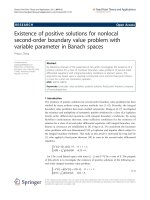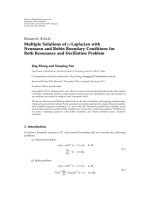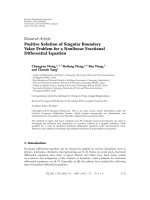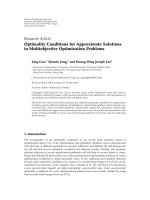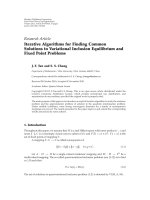Báo cáo hóa học: " Research Article Positive Solutions for Two-Point Semipositone Right Focal Eigenvalue Problem" potx
Bạn đang xem bản rút gọn của tài liệu. Xem và tải ngay bản đầy đủ của tài liệu tại đây (515.56 KB, 12 trang )
Hindawi Publishing Corporation
Boundary Value Problems
Volume 2007, Article ID 23108, 12 pages
doi:10.1155/2007/23108
Research Article
Positive Solutions for Two-Point Semipositone Right Focal
Eigenvalue Problem
Yuguo Lin and Minghe Pei
Received 28 March 2007; Revised 13 July 2007; Accepted 27 August 2007
Recommended by P. Joseph McKenna
Krasnoselskii’s fixed-point theorem in a cone is used to discuss the existence of positive
solutions to semipositone right focal eigenvalue problems (
−1)
n−p
u
(n)
(t) = λf(t,u(t),
u
(t), ,u
(p−1)
(t)), u
(i)
(0) = 0, 0 ≤ i ≤ p − 1, u
(i)
(1) = 0, p ≤ i ≤ n − 1, where n ≥ 2, 1 ≤
p ≤ n − 1isfixed,f : [0, 1] × [0,∞)
p
→ (−∞, ∞)iscontinuouswith f (t, u
1
,u
2
, ,u
p
) ≥
−
M for some positive constant M.
Copyright © 2007 Y. Lin and M. Pei. This is an open access article distributed under the
Creative Commons Attribution License, which permits unrestricted use, distribution,
and reproduction in any medium, provided the original work is properly cited.
1. Introduction
In recent years, many papers have discussed the existence of positive solutions of right
focal boundary value problems, see [1–7]. In 2003, Ma [5] established existence results of
positive solutions for the fourth-order semipositone boundary value problems
u
(4)
(x) = λf
x, u(x),u
(x)
,
u(0)
= u
(0) = u
(1) = u
(1) = 0.
(1.1)
Motivated by Agarwal and Wong [8]andMa[5], the purpose of this article is to gen-
eralize and complement Ma’s work to nth-order right focal eigenvalue problems:
(
−1)
n−p
u
(n)
(t) = λf
t,u(t), u
(t), ,u
(p−1)
(t)
(1.2)
with boundary conditions
u
(i)
(0) = 0, 0 ≤ i ≤ p − 1,
u
(i)
(1) = 0, p ≤ i ≤ n − 1,
(1.3)
2 Boundary Value Problems
where n
≥ 2, 1 ≤ p ≤ n − 1isfixed, f : [0,1] × [0,∞)
p
→ (−∞,∞)iscontinuouswith
f (t,u
1
,u
2
, ,u
p
) ≥−M for some positive constant M.
We say that u(t) is positive solution of BVP (1.2), (1.3)ifu(t)
∈ C
n
[0,1]issolutionof
BVP (1.2 ), (1.3)andu
(i)
(t) > 0, t ∈ (0,1), i = 0,1, , p − 1.
For other related works with focal boundary value problem, we refer to recent contri-
butions of Agarwal [1], Agarwal et al. [2], Boey and Wong [3], He and Ge [4], and Wong
and Agarwal [6, 7].
The outline of the paper is as follows: in Section 2, we will present some lemmas which
will be used in the proof of main results. In Section 3, by using Krasnoselskii’s fixed-point
theorem in a cone, we offer criteria for the existence of a positive solution and two positive
solutions of BVP (1.2), (1.3).
2. Some preliminaries
In order to abbreviate our discussion, we use C
i
(i = 1,2,3,4,5) to denote the follow ing
conditions:
(C
1
) f (t,u
1
,u
2
, ,u
p
) ∈ C([0,1] × [0,∞)
p
,(−∞,∞)) is continuous with f (t,u
1
,u
2
,
,u
p
) ≥−M for some positive constant M;
(C
2
) there exists constant 0 <ε<1suchthat
lim
u
1
,u
2
, ,u
p
→∞
min
t∈[ε,1]
f
t,u
1
,u
2
, ,u
p
+ M
u
p
=∞; (2.1)
(C
3
) there exists constant α>0suchthat
lim
u
p
→0
+
min
(t,u
1
,u
2
, ,u
p−1
)∈[0,1]×[0,α]
p−1
f
t,u
1
,u
2
, ,u
p
u
p
=∞; (2.2)
(C
4
) there exists constant α>0suchthat
f
t,u
1
,u
2
, ,u
p−1
,0
> 0,
t,u
1
,u
2
, ,u
p−1
∈
[0,1] × [0,α]
p−1
; (2.3)
(C
5
) h(s) = s
n−p
/(n − p)!, D
1
= (
1
0
h(s)ds)
−1
, D
2
= (
1
ε
h(s)ds)
−1
,where0<ε<1is
constant.
Let B
={u ∈ C
p−1
[0,1] : u
(i)
(0) = 0, 0 ≤ i ≤ p − 2} with the norm u=
sup
t∈[0,1]
|u
(p−1)
(t)|. It is easy to prove that B is a Banach space.
Lemma 2.1. Let
C
≡
u ∈ B : u
(p−1)
(t) ≥ tu, t ∈ [0,1]
. (2.4)
Then C is a cone in B and for all u
∈ C,
t
p−i
u
(p − i)!
≤ u
(i)
(t) ≤u, t ∈ [0,1], i = 0,1, , p − 1. (2.5)
Y. Lin and M. Pei 3
Proof. For all u, v
∈ C and for all α ≥ 0, β ≥ 0, we have
αu(t)+βv(t)
(p−1)
= αu
(p−1)
(t)+βv
(p−1)
(t)
≥ αtu + βtv
≥
tαu + βv,
(2.6)
so αu + βv
∈ C. In addition, if u ∈ C, −u ∈ C,andu = θ (where θ denotes the zero ele-
ment of B), then
u
(p−1)
(t) ≥ tu≥0, t ∈ [0,1],
−u
(p−1)
(t) ≥ tu≥0, t ∈ [0,1].
(2.7)
Thus u
(p−1)
(t) = 0, t ∈ [0,1]. It follows that u=0, which contradicts the assumption.
Hence C is a cone in B.
For all u
∈ C,0≤ i ≤ p − 1, due to Taylor’s formula, we have ξ ∈ (0,t)suchthat
u
(i)
(t) = u
(i)
(0) + u
(i+1)
(0)t + ···+
u
(p−2)
(0)t
p−i−2
(p − i− 2)!
+
u
(p−1)
(ξ)t
p−i−1
(p − i− 1)!
. (2.8)
It follows from u
∈ C that for i = 0,1, , p − 1,
u≥u
(i)
(t) =
u
(p−1)
(ξ)t
p−i−1
(p − i− 1)!
≥
tut
p−i−1
(p − i− 1)!
=
t
p−i
u
(p − i− 1)!
≥
t
p−i
u
(p − i)!
.
(2.9)
Lemma 2.2 [6]. Let K(t, s) be Green’s function of the differential equation (−1)
n−p
u
(n)
(t)= 0
subject to the boundary conditions (1.3). Then
K(t,s)
=
(−1)
n−p
(n − 1)!
⎧
⎪
⎪
⎪
⎪
⎪
⎪
⎪
⎨
⎪
⎪
⎪
⎪
⎪
⎪
⎪
⎩
p−1
i=0
n − 1
i
t
i
(−s)
n−i−1
,0≤ s ≤ t ≤ 1,
−
n−1
i=p
n − 1
i
t
i
(−s)
n−i−1
,0≤ t ≤ s ≤ 1,
∂
i
∂t
i
K(t,s) ≥ 0, (t,s) ∈ [0,1] × [0,1], 0 ≤ i ≤ p.
(2.10)
Lemma 2.3. Assume that (C
5
)holds.Letk(t,s) be Green’s funct ion of the differential equa-
tion
(
−1)
n−p
u
(n−p+1)
(t) = 0 (2.11)
subject to the boundary conditions
u(0)
= 0, u
(i)
(1) = 0, 1 ≤ i ≤ n − p. (2.12)
4 Boundary Value Problems
Then
th(s)
≤ k(t,s) ≤ h(s), (t, s) ∈ [0,1] × [0,1]. (2.13)
Proof. It is clear that
k(t,s)
=
∂
p−1
∂t
p−1
K(t,s) =
1
(n − p)!
⎧
⎨
⎩
s
n−p
,0≤ s ≤ t ≤ 1,
s
n−p
− (s − t)
n−p
,0≤ t ≤ s ≤ 1.
(2.14)
Obviously,
th(s)
≤
1
(n − p)!
s
n−p
≤ h(s), 0 ≤ s ≤ t ≤ 1. (2.15)
For 0
≤ t ≤ s ≤ 1,
h(s)
≥
1
(n − p)!
s
n−p
− (s − t)
n−p
=
1
(n − p)!
s − (s − t)
n−p−1
i=0
s
n−p−1−i
(s − t)
i
≥
1
(n − p)!
ts
n−p−1
≥
1
(n − p)!
ts
n−p
= th(s).
(2.16)
Thus,
th(s)
≤ k(t,s) ≤ h(s), (t, s) ∈ [0,1] × [0,1]. (2.17)
Lemma 2.4. The boundary value problem
(
−1)
(n−p)
u
(n)
(t) = 1, t ∈ [0,1],
u
(i)
(0) = 0, 0 ≤ i ≤ p − 1,
u
(i)
(1) = 0, p ≤ i ≤ n − 1,
(2.18)
has unique solution w(t)
∈ C
n
[0,1] and
0
≤ w
(i)
(t) ≤
t
p−i
(n − p)!(p − i)!
, t
∈ [0,1], 0 ≤ i ≤ p − 1. (2.19)
Proof. It is clear that t he boundary value problem
(
−1)
(n−p)
u
(n)
(t) = 1, t ∈ [0,1],
u
(i)
(0) = 0, 0 ≤ i ≤ p − 1,
u
(i)
(1) = 0, p ≤ i ≤ n − 1,
(2.20)
Y. Lin and M. Pei 5
has unique solution
w(t)
=
1
0
K(t,s)ds, (2.21)
where K(t,s)isasinLemma 2.2.
Obviously, for 0
≤ s ≤ t ≤ 1,
1
(n − p)!
s
n−p
≤
ts
n−p−1
(n − p − 1)!
. (2.22)
For 0
≤ t ≤ s ≤ 1,
1
(n − p)!
s
n−p
− (s − t)
n−p
=
1
(n − p)!
[s
− (s − t)]
n−p−1
i=0
s
n−p−1−i
(s − t)
i
≤ (n − p)
ts
n−p−1
(n − p)!
=
ts
n−p−1
(n − p − 1)!
.
(2.23)
So
0
≤ k(t,s) ≤
ts
n−p−1
(n − p − 1)!
, (2.24)
where k(t,s)isasinLemma 2.3.Sincew
(p−1)
(t) =
1
0
k(t,s)ds,then
0
≤ w
(p−1)
(t) =
1
0
k(t,s)ds ≤
1
0
ts
n−p−1
(n − p − 1)!
ds
=
t
(n − p)!
. (2.25)
Further, since w
(i)
(0) = 0, 0 ≤ i ≤ p − 1, we get
0
≤ w
(i)
(t) ≤
t
p−i
(n − p)!(p − i)!
, t
∈ [0,1], 0 ≤ i ≤ p − 1.
(2.26)
Lemma 2.5 [8]. Let E be a Banach space, and let C ⊂ E be a cone in E. Assume that Ω
1
, Ω
2
are open subsets of E with 0 ∈ Ω
1
⊂ Ω
1
⊂ Ω
2
,andletT : C ∩ (Ω
2
\ Ω
1
) → C be a completely
continuous operator such that e ither
(i)
Tu≤u, u ∈ C ∩ ∂Ω
1
, Tu≥u, u ∈ C ∩ ∂Ω
2
or
(ii)
Tu≥u, u ∈ C ∩ ∂Ω
1
, Tu≤u, u ∈ C ∩ ∂Ω
2
.
Then, T has a fixed point in C
∩ (Ω
2
\ Ω
1
).
3. Main results
In this section, by using Lemma 2.5,weoffer criteria for the existence of positive solutions
for two-point semipositone r ight focal eigenvalue problem (1.2), (1.3).
Theorem 3.1. Assume (C
1
), (C
2
), and (C
5
)hold.ThenBVP(1.2), (1.3) has at least one
positive solution if λ>0 is small enough.
6 Boundary Value Problems
Proof. We consider BVP
(
−1)
n−p
u
(n)
(t) = λf
∗
t,u(t) − φ(t), ,u
(p−1)
(t) − φ
(p−1)
(t)
,
u
(i)
(0) = 0, 0 ≤ i ≤ p − 1,
u
(i)
(1) = 0, p ≤ i ≤ n − 1,
(3.1)
where
φ(t)
= λMw(t)
w(t)isasinLemma 2.4
,
f
∗
t,u
1
,u
2
, ,u
p
=
f
t,ρ
1
,ρ
2
, ,ρ
p
+ M,
(3.2)
and for all i
= 1,2, , p,
ρ
i
=
⎧
⎨
⎩
u
i
, u
i
≥ 0;
0, u
i
< 0.
(3.3)
We w ill prove that (3.1)hasasolutionu
1
(t). Obviously, (3.1)hasasolutioninC if and
only if
u(t)
=
1
0
K(t,s)λf
∗
s,u(s) − φ(s),u
(s) − φ
(s), ,u
(p−1)
(s) − φ
(p−1)
(s)
ds
:
= (T
1
u)(t)
(3.4)
or
u
(p−1)
(t) =
1
0
k(t,s)λf
∗
s,u(s) − φ(s),u
(s) − φ
(s), ,u
(p−1)
(s) − φ
(p−1)
(s)
ds
:
=
T
1
u
(p−1)
(t)
(3.5)
has a solution in C.FromLemma 2.3,weknowthat
T
1
u
(p−1)
(t)
=
1
0
k(t,s)λf
∗
s,u(s) − φ(s),u
(s) − φ
(s), ,u
(p−1)
(s) − φ
(p−1)
(s)
ds
≤
1
0
h(s)λf
∗
s,u(s) − φ(s),u
(s) − φ
(s), ,u
(p−1)
(s) − φ
(p−1)
(s)
ds,
(3.6)
so
T
1
u
≤
1
0
h(s)λf
∗
s,u(s) − φ(s),u
(s) − φ
(s), ,u
(p−1)
(s) − φ
(p−1)
(s)
ds. (3.7)
Y. Lin and M. Pei 7
From Lemma 2.3 again,
T
1
u
(p−1)
(t)
=
1
0
k(t,s)λf
∗
s,u(s) − φ(s),u
(s) − φ
(s), ,u
(p−1)
(s) − φ
(p−1)
(s)
ds
≥
1
0
th(s)λf
∗
s,u(s) − φ(s),u
(s) − φ
(s), ,u
(p−1)
(s) − φ
(p−1)
(s)
ds
= t
1
0
h(s)λf
∗
s,u(s) − φ(s),u
(s) − φ
(s), ,u
(p−1)
(s) − φ
(p−1)
(s)
ds
≥ t
T
1
u
.
(3.8)
Hence, T
1
(C) ⊆ C. Further, it is clear that T
1
: C → C is completely continuous.
Let
λ
∈ (0,Λ) (3.9)
be fixed, w here
Λ
= min
2D
1
M
1
,
(n
− p)!
M
, (3.10)
M
1
= max
f
∗
t,u
1
,u
2
, ,u
p
:
t,u
1
,u
2
, ,u
p
∈
[0,1] × [0,2]
p
. (3.11)
We separate the rest of the proof into the following two steps.
Step 1. Let
Ω
1
=
u ∈ B : u < 2
. (3.12)
From the definition of f
∗
,weknow
M
1
= max
f
∗
t,u
1
,u
2
, ,u
p
:
t,u
1
,u
2
, ,u
p
∈
[0,1] × [0,2]
p
=
max
f
∗
t,u
1
,u
2
, ,u
p
:
t,u
1
,u
2
, ,u
p
∈
[0,1] × (−∞,2]
p
.
(3.13)
It follows from Lemma 2.3 and (C
5
)thatforallu ∈ ∂Ω
1
∩ C,
T
1
u
(p−1)
(t)
=
1
0
k(t,s)λf
∗
s,u(s) − φ(s),u
(s) − φ
(s), ,u
(p−1)
(s) − φ
(p−1)
(s)
ds
≤
1
0
h(s)λM
1
ds = λM
1
D
−1
1
< 2 =u.
(3.14)
Hence,
T
1
u
≤
u, u ∈ ∂Ω
1
∩ C. (3.15)
8 Boundary Value Problems
Step 2. From (C
2
), we know that there exists η>2(η can be chosen arbitr a rily large) such
that
σ :
= 1 −
λM
(n − p)!η
> 1
−
λM
2(n − p)!
>
1
2
, (3.16)
and for all (u
1
,u
2
, ,u
p
) ∈ [(ε
p
ση)/p!,∞)
p−1
× [εση,∞),
min
t∈[ε,1]
f
t,u
1
,u
2
, ,u
p
+ M
u
p
≥
2D
2
λε
≥
D
2
λεσ
. (3.17)
Then, for all (t,u
1
,u
2
, ,u
p
) ∈ [ε,1]× [(ε
p
ση)/p!,η]
p−1
× [εση,η],
f
t,u
1
,u
2
, ,u
p
+ M ≥
D
2
u
p
λεσ
≥
D
2
η
λ
. (3.18)
It follows from Lemmas 2.1 and 2.4 that for u
∈ C and u=η,
u
(i)
(t) − φ
(i)
(t) = u
(i)
(t) − λMw
(i)
(t)
≥ u
(i)
(t) −
λMt
p−i
(n − p)!(p − i)!
≥ u
(i)
(t) −
λMu
(i)
(t)
(n − p)!η
=
1 −
λM
(n − p)!η
u
(i)
(t)
≥
1 −
λM
(n − p)!η
t
p−i
η
(p − i)!
= σ
t
p−i
η
(p − i)!
, t
∈ [0,1] (by (3.16))
≥
⎧
⎪
⎨
⎪
⎩
ε
p
ση
p!
,0
≤ i ≤ p − 2, t ∈ [ε,1],
εση, i
= p − 1, t ∈ [ε,1].
(3.19)
Using Lemma 2.3 and (3.18), we know that
T
1
u
(p−1)
(1)
=
1
0
k(1,s)λf
∗
s,u(s) − φ(s),u
(s) − φ
(s), ,u
(p−1)
(s) − φ
(p−1)
(s)
ds
≥
1
ε
h(s)λ
D
2
η
λ
ds
=
1
ε
h(s)D
2
ηds= η =u.
(3.20)
Hence, let
Ω
2
=
u ∈ B : u <η
, (3.21)
Y. Lin and M. Pei 9
then
T
1
u
≥
u, u ∈ ∂Ω
2
∩ C. (3.22)
Thus, it follows from the first part of Lemma 2.5 that T
1
(u) = u has one fixed point u(t)
in C,suchthat2
≤u≤η.
Let
u
1
(t) = u(t) − φ(t). (3.23)
From Lemmas 2.1, 2.4,and(3.16), we know that for i
= 0,1, , p − 1,
u
(i)
1
(t) = u
(i)
(t) − φ
(i)
(t)
= u
(i)
(t) − λMw
(i)
(t)
≥ u
(i)
(t) −
λMt
p−i
(n − p)!(p − i)!
≥ u
(i)
(t) −
λMu
(i)
1
(t)
2(n − p)!
=
1 −
λM
2(n − p)!
u
(i)
(t)
≥
1 −
λM
2(n − p)!
2t
p−i
(p − i)!
>
t
p−i
(p − i)!
> 0, t
∈ (0,1].
(3.24)
This implies that
u
(i)
1
(t) > 0, t ∈ (0,1], i = 0,1, , p − 1. (3.25)
Further, we get
(
−1)
n−p
u
(n)
1
(t) = (−1)
n−p
u
(n)
(t) − λM
= λf
∗
t,u(t) − φ(t),u
(t) − φ
(t), ,u
(p−1)
(t) − φ
(p−1)
(t)
−
λM
= λf
t,u(t) − φ(t),u
(t) − φ
(t), ,u
(p−1)
(t) − φ
(p−1)
(t)
=
λf
t,u
1
(t),u
1
(t), ,u
(p−1)
1
(t)
.
(3.26)
So, u
1
(t) = u(t) − φ(t) is a positive solution of BVP (1.2), (1.3).
Thus, for λ
∈ (0,Λ), BVP (1.2), (1.3) has at least one positive solution.
Theorem 3.2. Assume (C
1
), (C
2
), (C
3
), and (C
5
)hold.ThenBVP(1.2), (1.3) has at least
two positive solutions if λ>0 is small enough.
10 Boundary Value Problems
Proof. It follows from Theorem 3.1 that, for λ
∈ (0,Λ), where Λ is as in (3.10), BVP (1.2),
(1.3) has positive solution u
1
(t)suchthat
u
1
> 1. (3.27)
Next, we will find the second positive solution. From (C
3
), we know that there exists
a
∈ (0,∞)suchthat
f
t,u
1
,u
2
, ,u
p
≥
0,
t,u
1
,u
2
, ,u
p
∈
[0,1] × [0,a]
p
. (3.28)
We consider the following BVP:
(
−1)
(n−p)
u
(n)
(t) = λf
∗∗
t,u(t), u
(t), ,u
(p−1)
, t ∈ [0,1],
u
(i)
(0) = 0, 0 ≤ i ≤ p − 1,
u
(i)
(1) = 0, p ≤ i ≤ n − 1,
(3.29)
where
f
∗∗
t,u
1
,u
2
, ,u
p
=
f
t,ρ
1
,ρ
2
, ,ρ
p
,
ρ
i
=
⎧
⎨
⎩
u
i
, u
i
∈ [0,a],
a, u
i
∈ (a,∞),
i
= 1,2, , p.
(3.30)
It is easy to prove that (3.29)hasasolutioninC if and only if operator
u(t)
=
1
0
K(t,s)λf
∗∗
s,u(s),u
(s), ,u
(p−1)
(s)
ds :=
T
2
u
(t) (3.31)
or
u
(p−1)
(t) =
1
0
k(t,s)λf
∗∗
s,u(s),u
(s), ,u
(p−1)
(s)
ds =
T
2
u
(p−1)
(t) (3.32)
has a fixed point in C. Moreover, it is easy to check that T
2
: C → C is completely contin-
uous.
Let
H
= min{1,a},
Λ
1
= min
Λ,
D
1
H
M
2
,
(3.33)
where Λ is as in (3.10)and
M
2
:= max
f
∗∗
t,u
1
,u
2
, ,u
p
:
t,u
1
,u
2
, ,u
p
∈
[0,1] × [0,a]
p
. (3.34)
Y. Lin and M. Pei 11
Let
λ
∈
0,Λ
1
(3.35)
be fixed.
Let
Ω
3
=
u ∈ B : u <H
. (3.36)
Then for u
∈ C ∩ ∂Ω
3
,wehavefromLemma 2.3 and (C
5
)that
T
2
u
(p−1)
(t) = λ
1
0
k(t,s) f
∗∗
t,u(s),u
(s), ,u
(p−1)
(s)
ds
≤ λ
1
0
h(s) f
∗∗
t,u(s),u
(s), ,u
(p−1)
(s)
ds
≤ λD
−1
1
M
2
<H.
(3.37)
Therefore,
T
2
u
≤
u, u ∈ C ∩ ∂Ω
3
. (3.38)
From (C
3
), there exist η, r
0
,whereλη
1
0
sh(s)ds > 1withr
0
<Hsuch that
f
∗∗
t,u
1
,u
2
, ,u
p
≥
ηu
p
,
t,u
1
,u
2
, ,u
p
∈
[0,1] ×
0,r
0
p
. (3.39)
For u
∈ C and u=r
0
,wehavefromLemma 2.3 and (3.39)that
T
2
u
(p−1)
(1) = λ
1
0
k(1,s) f
∗∗
s,u(s),u
(s), ,u
(p−1)
(s)
ds
= λ
1
0
h(s) f
∗∗
s,u(s),u
(s), ,u
(p−1)
(s)
ds
≥ λ
1
0
h(s)ηu
(p−1)
(s)ds
≥ λ
1
0
h(s)ηsuds (by the definition of C)
= λη
1
0
sh(s)dsu
> u.
(3.40)
Thus, let
Ω
4
=
u ∈ B : u <r
0
, (3.41)
then
T
2
u
≥
u, u ∈ C ∩ ∂Ω
4
. (3.42)
12 Boundary Value Problems
Therefore, it follows from the first part of Lemma 2.5 that BVP (3.29)hasasolution
u
2
such that
r
0
≤u
2
≤H. (3.43)
From the definition of f
∗∗
and Lemma 2.1,weknowthatu
2
is positive solution of BVP
(1.2), (1.3).
Thus, from (3.27), (3.33), and (3.43), we find that for λ
∈ (0,Λ
1
), BVP (1.2), (1.3)has
two distinct positive solutions u
1
and u
2
.
Corollary 3.3. Assume (C
1
), (C
2
), (C
4
), and (C
5
)hold.ThenBVP(1.2), (1.3) has at least
two positive solutions if λ>0 is small enough.
Proof. It is easy to prove from (C
4
)that(C
3
) holds. By using Theorem 3.2,weknowthat
the result holds.
Remark 3.4. By letting n = 4, p = 2inTheorem 3.1 and Corollary 3.3,wegetMa[5,
Theorems 1 and 2].
Acknowledgment
The authors thank the referee for valuable suggestions which led to improvement of the
original manuscript.
References
[1] R. P. Agarwal, Boundary Value Problems for Higher Order Differential Equations, World Scientific,
Singapore, 1986.
[2] R. P. Agarwal, D. O’Regan, and V. Lakshmikantham, “Singular (p,n
− p) focal and (n, p) higher
order boundary value problems,” Nonlinear Analysis: Theory, Methods & Applications, vol. 42,
no. 2, pp. 215–228, 2000.
[3] K. L. Boey and P. J. Y. Wong, “Two-point right focal eigenvalue problems on time scales,” Applied
Mathematics and Computation, vol. 167, no. 2, pp. 1281–1303, 2005.
[4] X. He and W. Ge, “Positive solutions for semipositone (p,n
− p) right focal boundary value
problems,” Applicable Analysis, vol. 81, no. 2, pp. 227–240, 2002.
[5] R. Ma, “Multiple positive solutions for a semipositone fourth-order boundary value problem,”
Hiroshima Mathematical Journal, vol. 33, no. 2, pp. 217–227, 2003.
[6] P. J. Y. Wong and R. P. Agarwal, “Multiple positive solutions of two-point right focal boundary
value problems,” Mathematical and Computer Modelling, vol. 28, no. 3, pp. 41–49, 1998.
[7] P. J. Y. Wong and R. P. Agarwal, “On two-point right focal eigenvalue problems,” Zeitschrift f
¨
ur
Analysis und ihre Anwendungen, vol. 17, no. 3, pp. 691–713, 1998.
[8] R. P. Agarwal and F H. Wong, “Existence of positive solutions for non-positive higher-order
BVPs,” Journal of Computational and Applied Mathematics, vol. 88, no. 1, pp. 3–14, 1998.
Yuguo Lin: Department of Mathematics, Bei Hua University, JiLin City 132013, China
Email address:
Minghe Pei: Department of Mathematics, Bei Hua University, JiLin City 132013, China
Email address:
